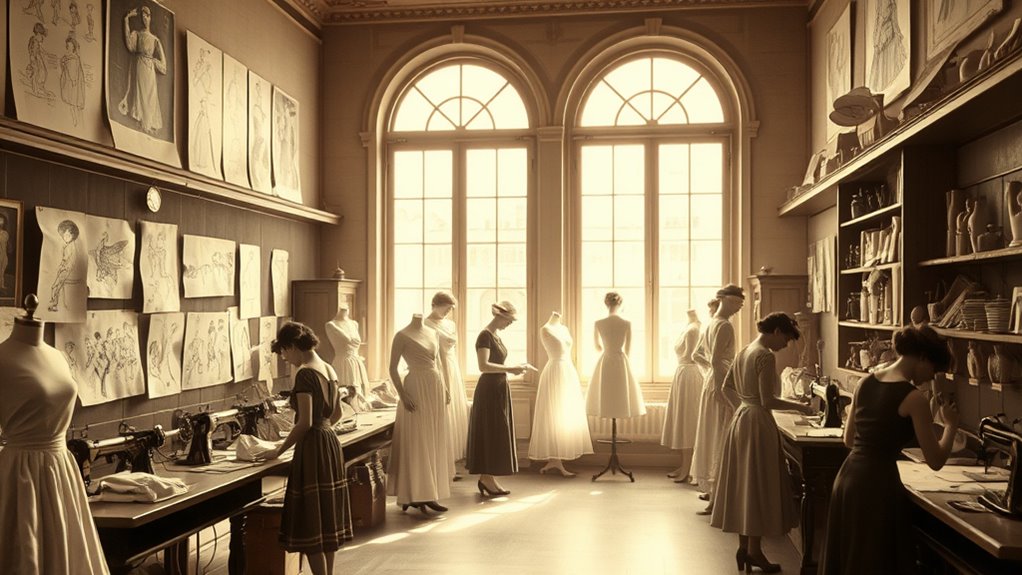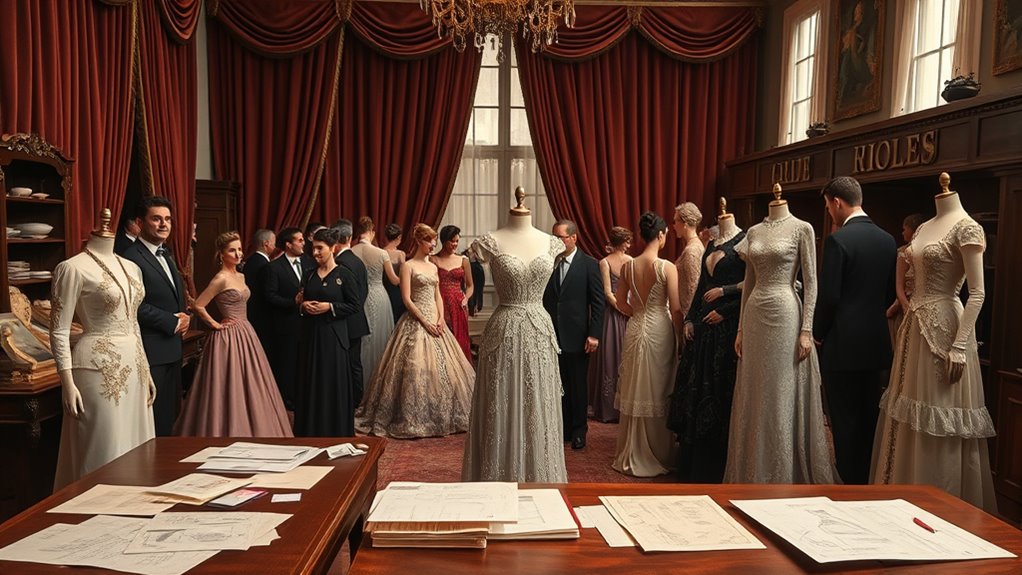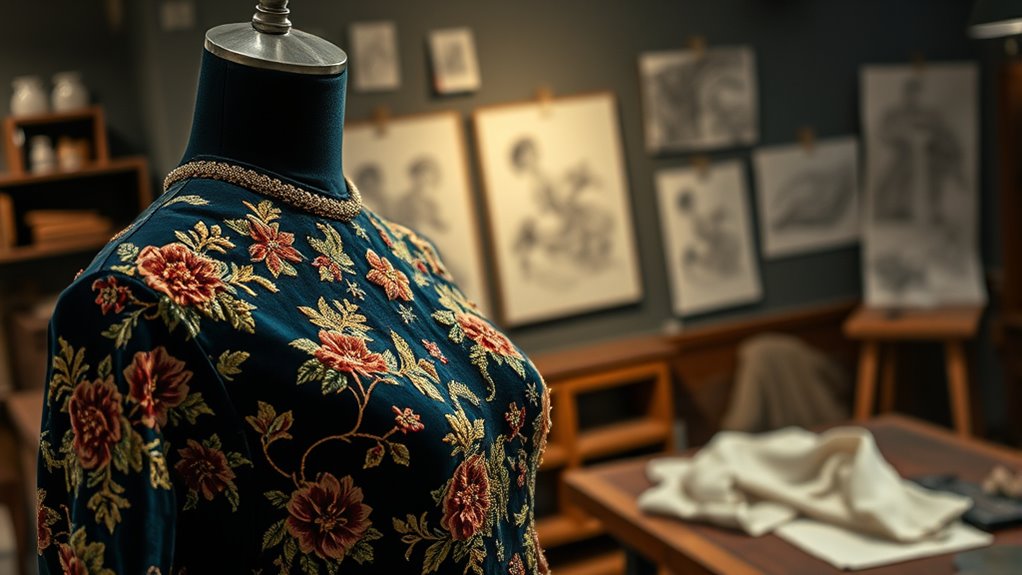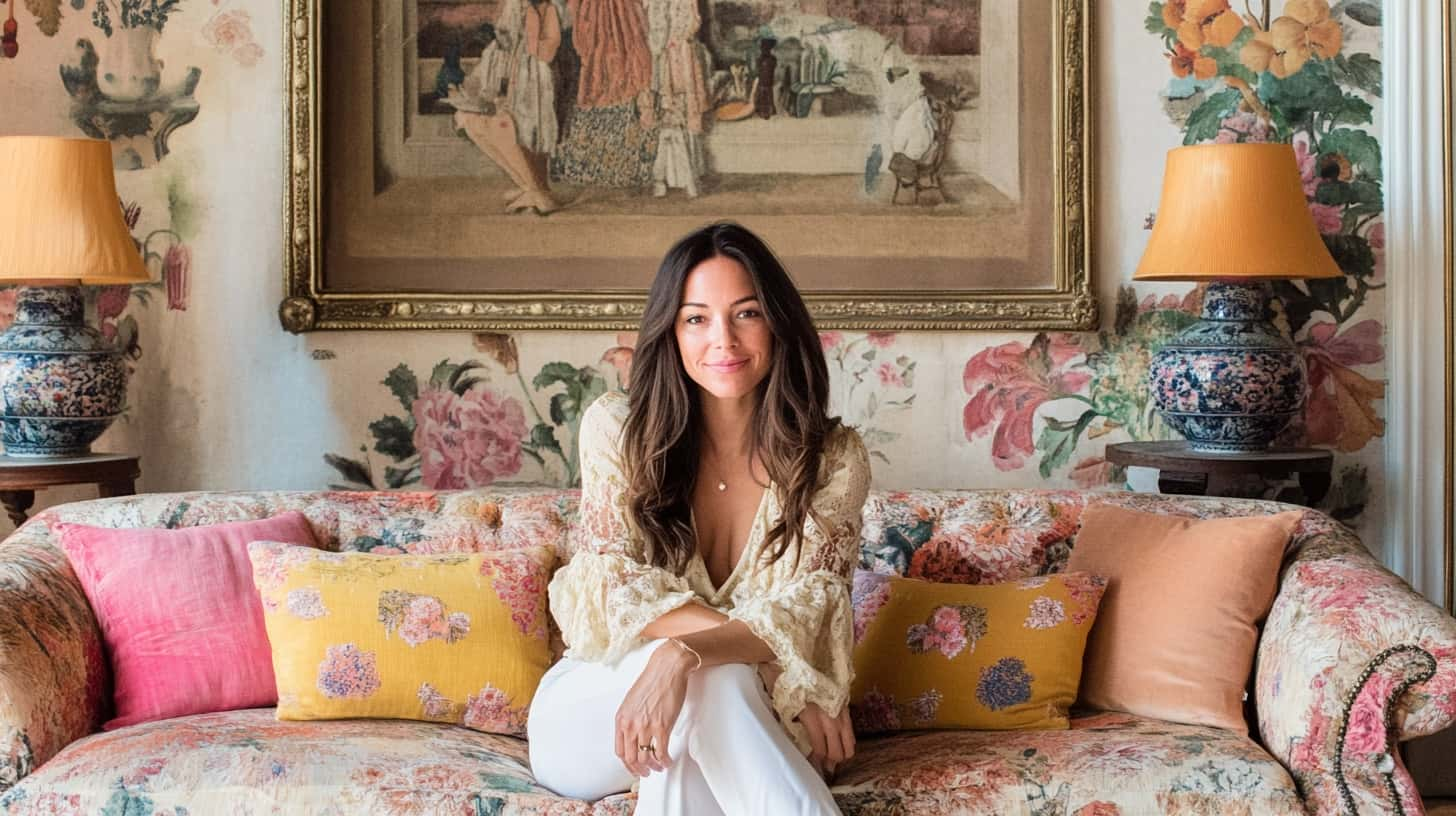Haute couture began in Paris in the 19th century, transforming fashion into an exclusive art form. Pioneering designers like Charles Worth elevated craftsmanship, luxury, and creativity, turning clothing into wearable masterpieces. The industry’s development was regulated by the Chambre Syndicale, ensuring quality and innovation. Today, haute couture continues to blend tradition with modern tech, shaping cultural identity and artistic expression. Explore further to uncover how this glamorous world constantly evolves while honoring its artistic roots.
Key Takeaways
- Haute couture originated in 19th-century France, emphasizing exclusive, custom-fitted garments that blend fashion with fine art.
- Pioneering designers like Charles Worth established branding, craftsmanship, and seasonal collections, elevating fashion to an artistic craft.
- The industry is regulated by institutions such as the Chambre Syndicale de la Haute Couture, ensuring quality and exclusivity.
- Haute couture reflects societal values and cultural identity, inspiring broader trends and preserving traditional techniques.
- Contemporary innovations in digital technology and sustainability shape the future of haute couture as a blend of art, culture, and technological advancement.
Origins and Early Developments in Paris

Paris became the birthplace of haute couture in the mid-19th century, when innovative designers began creating custom-fitted garments for wealthy clients. You can see how designers like Charles Frederick Worth revolutionized fashion by introducing the concept of seasonal collections and branding. They moved away from mass production, focusing instead on craftsmanship and exclusivity. The Parisian ateliers became centers of creativity, where skilled artisans worked tirelessly to perfect every detail. This era marked the beginning of fashion as an art form, blending aesthetics with technical mastery. As wealthy clients sought unique, tailored pieces, Paris solidified its reputation as the world’s fashion capital. These early developments laid the foundation for the modern haute couture industry, emphasizing artistry, craftsmanship, and personalized luxury. Furthermore, the influence of these pioneering designers helped establish fashion as an art and culture, inspiring future generations of creators and enthusiasts alike. Additionally, the emphasis on craftsmanship and technical mastery elevated fashion to a respected art form, influencing artistic expression beyond clothing. The focus on innovative techniques in design further propelled Paris to the forefront of artistic and cultural innovation in fashion. This tradition of innovation continues to shape the industry today, highlighting the importance of technological advancements in fashion design. Moreover, the integration of new materials and design technologies has allowed designers to push creative boundaries further than ever before.
The Rise of the Chambre Syndicale De La Haute Couture

How did the organized regulation of haute couture come to be? It started in 1868 when the Chambre Syndicale de la Couture Parisienne was established to bring order to the industry. Over time, it evolved into the Chambre Syndicale de la Haute Couture in 1868, formalizing standards. This organization:
The regulation of haute couture began in 1868 with the establishment of the Chambre Syndicale de la Couture Parisienne to ensure industry standards.
- Sets strict criteria for membership, ensuring quality and exclusivity
- Regulates what qualifies as haute couture, maintaining high standards
- Coordinates fashion shows, giving designers a platform
- Protects the industry’s reputation, fostering trust and prestige
- Influences the overall Bedroom design trends that complement haute couture aesthetics
Iconic Designers and Their Contributions
Throughout history, certain designers have profoundly shaped haute couture, elevating it from craftsmanship to art. You recognize figures like Charles Frederick Worth, who pioneered the idea of designers as artists with signature styles and branding. Coco Chanel revolutionized fashion by introducing simplicity, elegance, and the little black dress, making high fashion more accessible and modern. Christian Dior transformed the industry with his New Look, emphasizing femininity and luxury after wartime austerity. Yves Saint Laurent broke boundaries by blending art and fashion, popularizing tuxedo suits for women. These designers didn’t just create clothing—they set standards, inspired movements, and influenced culture. Their innovations continue to inspire today’s designers, ensuring haute couture remains a dynamic intersection of creativity, craftsmanship, and cultural expression. Additionally, the use of color accuracy and innovative textiles in their collections helped elevate fashion to an art form that resonates across cultural boundaries. Moreover, the integration of cultural influences and technological advancements has expanded the horizons of haute couture, allowing designers to push creative limits further. Recognizing the importance of professional training, many of these designers developed skills that combined artistry with technical mastery, contributing to the enduring prestige of haute couture. Their ability to adapt to changing societal trends has kept haute couture relevant and influential in contemporary culture. Additionally, the growing influence of global markets has encouraged designers to incorporate diverse cultural elements into their work, enriching haute couture’s artistic landscape.
Haute Couture’s Role in Shaping Cultural Identity

Haute couture plays a powerful role in shaping cultural identity by reflecting and reinforcing societal values, traditions, and aspirations. It acts as a mirror of a community’s history and ideals. To understand this impact:
- It preserves cultural heritage through traditional techniques and motifs.
- It challenges norms by introducing innovative designs that spark societal conversations.
- It celebrates national identity via iconic styles tied to specific regions or periods.
- It influences popular culture, inspiring art, film, and everyday fashion.
- Additionally, haute couture can serve as a form of cultural expression, showcasing unique identities and fostering pride within communities. The use of traditional techniques in haute couture underscores its role in maintaining and honoring cultural histories. Incorporating elements of fashion as art further elevates couture as a form of cultural storytelling.
Contemporary Innovations and the Future of Haute Couture

As haute couture continues to evolve, designers are pushing boundaries by integrating cutting-edge technologies and sustainable practices. You’ll see digital tools like 3D printing and virtual prototyping revolutionize how garments are created, reducing waste and increasing efficiency. Wearable tech and smart fabrics are transforming traditional designs, blending fashion with innovation. Sustainability becomes central, with designers sourcing eco-friendly materials and adopting ethical production methods. The future of haute couture isn’t just about luxury; it’s about responsibility and innovation. You can expect more collaborations between fashion houses and tech companies, pushing the limits of creativity. As the industry embraces digital platforms, digital fashion shows and virtual fittings will become commonplace. Ultimately, haute couture will continue evolving as a dynamic art form, reflecting technological progress and societal values, with sustainable materials playing a crucial role in shaping its future. Additionally, the integration of digital fabrication techniques is enabling greater customization and precision in design. Furthermore, ethical labor practices are increasingly influencing brand reputation and consumer trust in high fashion. Emphasizing innovative craftsmanship will help maintain the artistry that defines haute couture while adapting to modern demands. Moreover, the incorporation of mental well-being practices can foster a more mindful creative environment within the industry, promoting sustainable success.
Frequently Asked Questions
How Did Non-European Cultures Influence Haute Couture Design Styles?
You see, non-European cultures influence haute couture through their vibrant textiles, intricate embroidery, and unique patterns, inspiring designers worldwide. By incorporating traditional motifs and craftsmanship, they add richness and diversity to high fashion. This cross-cultural exchange broadens creative horizons, allowing couture to become a global art form. Your favorite designers often draw from these diverse cultural elements, blending them seamlessly into luxurious, innovative designs that celebrate worldwide heritage.
What Economic Factors Most Impacted Haute Couture’s Evolution Over the Centuries?
Ever wonder what shapes haute couture’s growth? Economic factors like the rise of the wealthy elite fueled demand for exclusive, handcrafted designs. During economic booms, you’ll see more investment in luxury fashion, while downturns force designers to innovate or cut costs. You might notice how post-war recovery and globalization expanded markets, making couture more accessible and influencing design trends. These economic shifts directly impact the evolution of high fashion over centuries.
How Has Haute Couture Been Affected by Global Political Changes?
You see, global political changes have considerably influenced haute couture by shifting economic stability and cultural values. When nations face upheavals, designers often adapt their collections to reflect new realities or seek markets elsewhere. Political tensions can limit international collaborations or restrict resources, impacting production and innovation. Conversely, periods of peace and stability encourage growth, allowing haute couture to flourish creatively and commercially across borders.
What Role Do Haute Couture Houses Play in Sustainable Fashion Movements?
You see, haute couture houses are increasingly embracing sustainable fashion by adopting eco-friendly materials, ethical production, and reducing waste. They play a vital role in setting industry standards and inspiring others to follow suit. By showcasing innovative, sustainable designs on global platforms, they influence consumer behavior and promote environmental consciousness. Your awareness of their efforts highlights the growing importance of sustainability within the luxury fashion world.
How Do Cultural Perceptions of Luxury Impact Haute Couture’s Global Market?
You see that cultural perceptions of luxury greatly influence haute couture’s global market. When societies value exclusivity, craftsmanship, and heritage, they boost demand for high-end fashion. Conversely, shifting attitudes towards sustainability and accessibility challenge these perceptions, prompting you to adapt by emphasizing craftsmanship and storytelling. By understanding these cultural nuances, you can better navigate markets, appeal to diverse tastes, and sustain the allure of haute couture worldwide.
Conclusion
As you explore haute couture’s rich tapestry, you’re witnessing more than just fashion—you’re glimpsing a living artwork that dances between tradition and innovation. It’s a shimmering mirror reflecting cultural dreams, a timeless melody played on fabric and thread. Embrace this world, where craftsmanship and creativity intertwine like a masterful brushstroke, shaping a vibrant future. Haute couture invites you to see fashion not just as clothing, but as an enthralling expression of art and soul.










